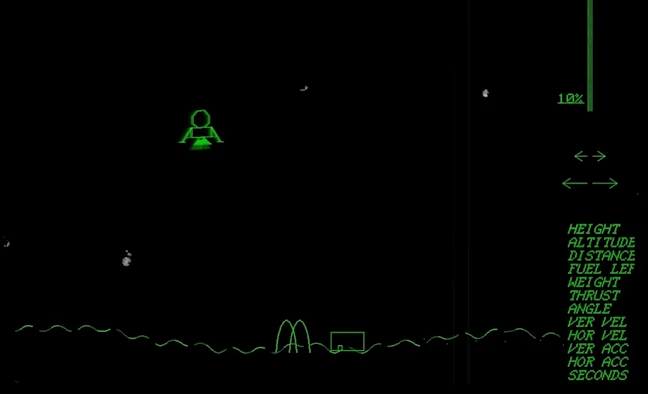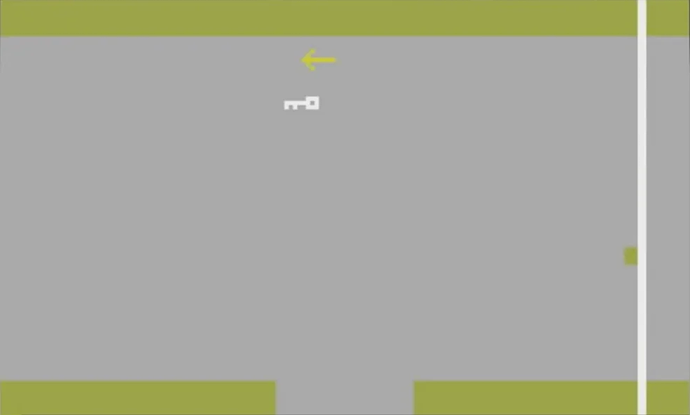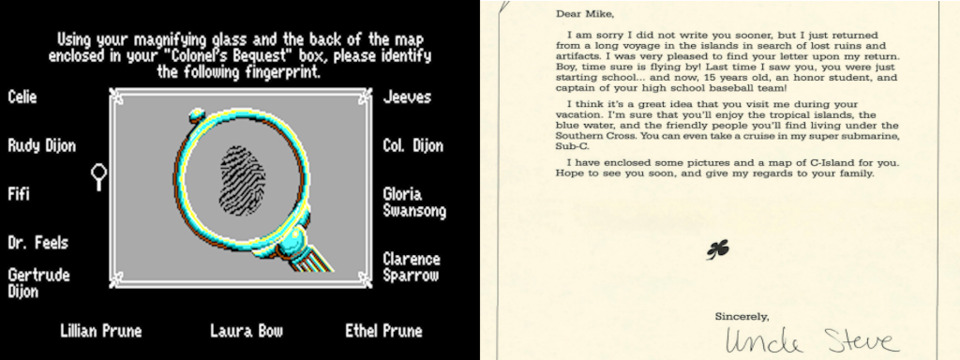Innovation of the Week: Meta Moments and Fourth Wall Breaks
By alianger 1 Comments
This week, let's delve into two interesting narrative tools that can express themselves a bit differently in video games: The meta moment and the fourth wall break. First off I am not talking about the more recent, alternative meaning of meta, which basically means the optimal strategy/ies to win in a game and tends to be used when talking about competitive MP games. Meta moments are when a game self-references or reflects upon its own mechanics, narrative, or existence within the game world. Fourth wall breaking moments directly address the player outside the game world, acknowledging their presence as a player, while not necessarily commenting on the game's mechanics, narrative or existence within the game world. While meta moments can also be fourth wall breaking to an extent, it's often not stated explicitly when one happens.
Meta moments can provide additional depth to a story or setting, break or enhance immersion, comment on something regarding the game's (or other games', media or society) story or mechanics, be used as a joke and/or just to screw with the player. Fourth wall breaks can also achieve these things as well as serve as an anti-piracy/copy protection measure in combination with physical material that came with the games - probably the most common usage in older PC games. For the meta tool it is probably as an instructional tool, with game characters, signposts or narrator voices referencing mechanics or controls as part of a game's tutorial. But let's focus on the unusual, funny, and/or ambitious here.

As I've talked about before, Moonlander (1973) includes one of the first secrets/easter eggs in video games, which also happens to be possibly the first meta moment as well as a pretty unusual one. Flying far enough in one direction will lead you to a McDonald's on the moon, and landing near it makes your astronaut walk into the restaurant and order a "TWO CHEESEBURGERS AND A BIG MAC TO GO". You can also land on the McDonald's and destroy it, causing the game to call you a clod. Through this easter egg, the game breaks the reality of the game's setting to insert a funny and unexpected reference to the international fast-food chain, which could also be interpreted as a satirical comment on what humanity would inevitably bring to other planets or planetary bodies when colonizing them. The bar is set pretty high and it's just 1973!
Some Other Notable Retro Game Examples:
Zork (1977/1980) - This influential text adventure game begins in front of a small white house. If you open the mailbox in front of that house, you'll find an advertising brochure for the very game you're actually playing. Infocom was also famous for including "feelies" in the boxes of it's games, actual 3D props that helped set the mood, and occasionally had an actual gameplay purpose - Thanks to Iamn0man at Reddit!

Adventure (A2600, 1980): This pioneering action adventure game features an early easter egg which is also a meta element and a fourth wall break - Creator Warren Robinett's secret room. A concealed gray dot, when found and carried to a room with one of the forcefields (along with two more other objects), opens a path through the forcefield to a hidden room to the right of it. Here the game reveales the message: "Created by Warren Robinett.", acknowledging its own development and the presence of the player. This hidden developer room or message idea has since appeared in several other well known games such as Boulder Dash (AII), Alex Kidd in Miracle World, Final Fantasy IV and Zombies Ate My Neighbors (although here you will go to it after beating the game rather than it being hidden). Legend of Zelda: A Link to the Past would feature a room that instead acknowledges Chris Houlihan, winner of a Nintendo Power competition.
Edit: Starship 1 (1977) is the first Arcade game with a hidden fourth wall breaking message. By activating the machine's controls in the appropriate sequence, the game displays the message "Hi Ron!" (referring to Ron Milner) and gives the player ten free games.

The Prisoner (Apple II, 1980) - This adventure/puzzle game features a fourth wall break where the player receives a 3-digit number at the beginning of the game, and is warned never to reveal it. The game then pulls numerous dirty tricks to get the player to do so, including faking an Apple II BASIC syntax error.
Lazy Jones (C64, 1984) - A game with a meta theme and a bit of a self-deprecating tone; it's a game about playing video games, where you move between rooms and play various smaller games in one of the first mini-game compilations. This idea would be reused in some later games such as Wing Commander and Shenmue, but only as a minor aspect of those games.
Little Computer People (C64, 1985/AMI, 1987) - In this early (the first?) life sim, there's a cute fourth wall break where the NPC in the house sometimes knocks on the screen if you don't do anything and will also write you worried letters if you neglect him/her completely.

Startropics (NES, 1990) - This action adventure starring a kid called Mike features a fourth wall breaking puzzle and anti-piracy/second hand measure. This in itself is similar to using maps or other documentation that came with previous games (such as runes in Ultima) to progress. But here there's a cool twist to it. Players can find a physical paper letter inside the game's box, made to appear as if it's signed by the in-game character Uncle Steve. The letter talks a bit about Mike's childhood and why the player is where they are at the beginning of the game, while also referencing some pictures, the submarine in-game and a map of "C-Island" to help the player. Later on in the game, the player is asked to dip the letter in actual water, revealing a secret code needed to progress. It was a pretty clever way to draw players into the adventure while also serving as copy protection.
Other creative or in-context anti-piracy examples also exist. In Star Trek: 25th Anniversary (1992), when it's time to warp to a new location, players without access to the manual will find that none of the systems are labelled in-game. You need to reference a star map in the manual to warp to the correct location, otherwise you'll find yourself being attacked by enemy ships.
In the murder mystery adventure game The Colonel's Bequest (1989), an intricate form of copy protection is used. Included with the game is a cardboard magnifying glass featuring a red plastic lens, used to reveal fingerprints on the back of a map. Upon starting the game, players are presented with a random fingerprint and have to use the map to correctly identify who it belongs to. While this may seem like a lot just to start playing, it seamlessly integrates with the game's narrative and theme.

X-Men (MD, 1993) - In this action platformer, there's a cryptic fourth wall breaking puzzle in the late-game that confused many players. After the Mojo boss, the game requires you to destroy a computer in-game, then reset the Mega Drive console itself in order to proceed to the final level. The game makes no real effort to clarify this, only telling the player to "disable and then reset the computer that controls the danger room" before that level begins. In the pre-internet era of gaming, this was an odd one, especially considering the rest of the game is pretty straightforward. Worse still, if the button was held down for a bit too long, the game would simply reset as normal and all progress would be lost! Nevertheless, for those who did figure it out it was a cool moment.

Mother 2/Earthbound (1994) - This posthumously popular JRPG had both some meta moments and a fourth wall break in store. For the former, there are some humourous references to game mechanics by random NPCs - that in itself wasn't new for console games at this point. There's also your dad reminding you to take a break from the game every time you save (or sometimes if you play too long without saving), which is cute but more of an annoyance after a while. For the latter, it does something different - a sudden religious twist. Shortly after the player makes a reservation for Club Stoic in the town Summers, Tony - Jeff's roommate early in the game - asks the player for their name, then calls to confirm it later after being rescued from the Stonehenge base. This seemingly trivial fourth wall break comes into play again in the finale of the game, when the player has to pray to defeat Giygas, its main antagonist. It's the only thing that can defeat Giygas. This is done through Paula's prayer ability, which in the narration of the game is described as touching the player, then the player is mentioned by name and the narrator says that they are also praying. While doing so, there are scenes showing other characters that the party has come to know during their journey do the same.

Date-based Content (Rise of the Triad: Dark War (1994), Christmas Nights (1996), Dungeon Keeper (1997)) - Some games feature different events or messages on different dates based on the internal clock of the system they're played on, having the game worlds acknowledge the real world and them existing virtually on the systems they're played on. In Rise of the Triad, on Christmas Day, the game replaces the loading screen and plays God Rest Ye Merry Gentlemen. Christmas Nights includes an alternate version of the first level of regular Nights, which also has a winter version appearing only during winter time, along with an alternate title screen theme and a Santa Claus cameo during december 24th-25th. There's also a "happy new year" message from Jan 1st to Jan 15th, and a few more things. In Dungeon Keeper, there's a birthday wish to a developer that shows on their birthday and six other messages.

Secret of Evermore (1995) - This Secret of Mana-inspired ARPG has several fourth wall breaks, generally used for jokes. Perhaps the most interesting one happens at the Nobilia Market, where the protagonist meets an old man in a green robe who rants about how people have no free will and are puppets of a button pressing madman. The player can then press a button to determine what sort of punishment he'll be subjected to. It's also possible to press the cancel button (Y) and receive a reward for your mercy, a piece of armor called a stone vest.

Harvester (PC, 1996) - A horror themed FMV/Pre-render-based Adventure game with a meta fictional theme. I'll let Arale from HG101's forums describe this one: "The fact that the town of Harvest is a simulation means that, essentially, it's a video game. The game was made as a reaction to the concept of video games causing violence, and that's what this is about - what would a video game have to do to ACTUALLY do that? It would have to be an immersive experience that puts you in situations in which you become accustomed to killing. A line from the Lodge's art gallery owner talks about how "when confronted with a work of hideous form, you're forced to deal with it, even if only to dismiss it as trash", referring to how the public reacts to violent art. And in the ending in which Steve becomes a serial killer, he actually plays Harvester and his mom reacts to it. The fact that the game advertises itself as "the most violent adventure game of all time" on the box art is misleading - it's actually ABOUT the most violent adventure game of all time, in-universe."

Metal Gear Solid (1998) - MGS had some of the most well remembered examples of fourth wall breaks. First, at one point the player is ordered to contact Meryl using the contact frequency code found on "the back of the CD case", referring to the actual CD case of the game. Most people probably needed som help with this one, but it is also possible to either brute force the frequency or find it in the instruction manual. Or you can keep contacting the colonel and you'll get a more direct response. Second, Ocelot will remind the player to save before the game's torture segment, and also warns them not to use an auto-fire feature to get past it or "he'll know" and kill Snake. Third, when fighting Psycho Mantis he can use his psychich powers to vibrate your controll, and he can also sense your memory card saves and if you have any Konami game ones on there, which he'll then comment on briefly. During the fight, players are also told to swap controller ports on the PS1 console to prevent the boss from reading their moves. This one's unique in that it resonates with the boss's psychic abilities in-game, so it serves as characterization.
---
What's your favorite example of a meta moment or fourth wall break in a video game, and why does it stand out to you? Share your thoughts and memories!
